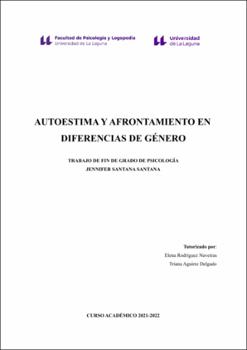Autoestima y Afrontamiento en Diferencias de Género
Fecha
2022Resumen
La autoestima es un factor importante en la vida de las personas. Es un constructo
fundamental asociado a la construcción de la personalidad, la satisfacción con la vida, y los
entornos personal, social y escolar. Todo esto es muy importante en la adolescencia, ya que
cuanto mayor sea la autoestima, se tendrá una mejor adaptación e influirá de manera positiva
en el entorno. Por otra parte, el afrontamiento, es decir los esfuerzos que hace una persona
para enfrentarse al estrés, es otro factor fundamental en esta etapa. Los adolescentes se
enfrentan a grandes demandas debido a su entorno, lo cual hace que deban elegir diferentes
estrategias de afrontamiento dependiendo del contexto, con la intención de disminuir los
efectos negativos que se producen debido a las demandas que se generan. La perspectiva de
género es importante porque se piensa que hombres y mujeres se consideran de manera
distinta, por lo que es de esperar que la autoestima y los estilos de afrontamiento sean
diferentes dependiendo del género. Este estudio plantea conocer las diferencias de género en
autoestima y afrontamiento y comprobar la capacidad predictiva de los estilos de
afrontamiento en la autoestima en la adolescencia. Para ello se analizó una muestra de 1188
estudiantes, tanto de género femenino como masculino, de primero a tercero de la ESO en
diferentes centros de la Comunidad Autónoma de Canarias. La investigación transversal
concluye que existen diferencias significativas entre hombres y mujeres respecto a la
autoestima, a favor de los hombres. Desde la perspectiva de afrontamiento, no se encontraron
diferencias significativas en el número de estrategias que usan los hombres y las mujeres. Si
se encontraron diferencias en el tipo de estrategias utilizadas; en el caso de las mujeres, son
centradas en la acción social, y en el caso de los nombres, centradas en la distracción física. Self-esteem is an important factor in people’s lives. It is a fundamental construct associated
with the construction of personality, satisfaction with life, and personal, social and school
environments. All of this is very important in adolescence, since the higher the self-esteem,
the better adaptation and positive influence on the environment. On the other hand, coping,
the efforts a person makes to deal with stress, is another fundamental factor at this stage.
Adolescents face great demands due to their environment, which means that they must
choose different coping strategies depending on the context, with the intention of reducing
the negative effects that are produced due to the demands that are generated. The gender
perspective is important because it is believed that men and women consider themselves
differently, so it is to be expected that self-esteem and coping styles are different depending
on gender. This study set out to know the gender differences in self-esteem and coping and to
test the predictive capacity of coping styles on self-esteem in adolescence. For this purpose,
we will analyze a sample of 1188 students, both female and male, from the first to the third
year of ESO in different centers of the Autonomous Community of the Canary Islands. The
cross-sectional research concludes that there are significant differences between men and
women when it comes to self-esteem, in favor of men. From the perspective of coping, no
significant differences were found in the number of coping strategies used by men and
women. Differences were found in the type of strategies used; in the case of women, they are
centered on social action, and in the case of men, they are centered on physical distraction.





